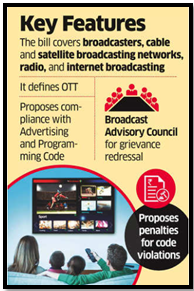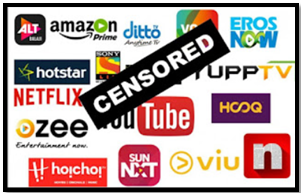DRAFT BROADCASTING EDUCATION BILL, 2023
Relevance:
GS 2
- Government policies and interventions for development in various sectors and issues arising out of their design and implementation.
Why in News:
- Recently, the draft Broadcasting Services Regulation Bill 2023 has been released by the Ministry of Information and Broadcasting for public consultation.
Source- Hindu Post
The Ministry of Information and Broadcasting (MIB) introduced the draft Broadcasting Services (Regulation) Bill, 2023, aiming to streamline existing broadcasting industry regulations and replace the Cable Television Networks (Regulation) Act, 1995.
The Bill intends to unify regulatory guidelines and includes OTT service operators, digital media platforms, and direct-to-home operators, alongside traditional broadcast networks. While incorporating provisions from various acts like the Information Technology Act, 2000, and the Telecom Regulatory Authority of India Act, 1997, the Bill supplements rather than replaces them.
Key Features
The Bill introduces streamlined regulatory processes and expands its scope to cover OTT content and digital news. It offers contemporary definitions and provisions for emerging technologies and comprises six chapters, 48 sections, and three schedules.
Source- The Economic Times
- Consolidation and Modernization: Addresses the need for a unified legislative framework, streamlining regulatory processes, and extends regulation to OTT content and digital news currently governed under the IT Act, 2000.
- Contemporary Definitions and Provisions: Introduces comprehensive definitions for modern broadcasting terms and includes provisions for emerging broadcasting technologies.
- Strengthened Self-Regulation: Enhances self-regulation with ‘Content Evaluation Committees’ and evolves the Inter-Departmental Committee into a participative ‘Broadcast Advisory Council’.
- Distinct Programme and Advertisement Codes: Allows differentiated Programme and Advertisement Codes for various services, requiring self-classification and robust access control for restricted content.
- Accessibility for Persons with Disabilities: Mandate for broadcasting services to be accessible to persons with disabilities through guidelines enforced by the Ministry of Information and Broadcasting (MIB). Requirements for subtitles, audio-description, sign language translation, etc.
- Statutory Penalties: Introduces statutory penalties like advisory warnings, censures, or fines for operators, reserving imprisonment or fines for serious offenses, ensuring a balanced regulatory approach.
- Equitable Penalties: Monetar penalties are tailored to the entity’s financial capacity, ensuring fairness based on investment and turnover.
- Infrastructure Sharing and Right of Way: Includes provisions for infrastructure sharing among broadcasters, platform service carriage, and efficient mechanisms for Right of Way, ensuring structured dispute resolution.
- Broadcast Advisory Council (BAC): Constitution of BAC to adjudicate grievances regarding Programme Code or Advertisement Code violations.
Advantages of Broadcasting Services Regulations Bill 2023:
- Ease of Doing Business: Incorporates Dispute Resolution mechanisms to facilitate business transactions in the broadcasting domain.
- Boost to ‘Digital India’: Fosters technological advancements and service evolution, supporting the ‘Digital India’ initiative.
- Facilitation of ‘Right of Way’: Enables cable operators to secure permissions easily from local agencies for network expansion in new areas.
- Infrastructure Sharing Promotion: Provides benefits akin to telecom operators, encouraging infrastructure sharing among broadcasters.
- Empowerment through Self-regulation: Establishes Content Evaluation Committees for self-certification, granting autonomy to the broadcasting industry.
- Enhanced Accessibility: Promotes ease of living by improving broadcasting services’ accessibility for persons with disabilities through subtitles, audio descriptors, and sign language.
- Empowers Consumers: The bill empowers consumers by providing them with a transparent and accountable grievance redressal mechanism.
- Promotes Content Diversity: The bill encourages the creation of a diverse and inclusive content ecosystem that reflects the rich cultural tapestry of India.
Concerns
Source- International Journal of advanced legal Research
- Threat of Censorship: Government-prescribed codes could curb creativity and democratic discourse. Officials can restrict broadcasts, raising concerns of potential misuse for censorship.
- Content Evaluation Committees (CEC) Issues: Criteria set by the government for CEC constitution questions its independence. Disclosure of personal details of CEC members risks privacy infringement and harassment.
- Broadcast Advisory Council (BAC) Concerns: All BAC members nominated by the Centre, potentially enabling government-driven censorship.
- Selective Targeting of Journalists: Risks selective targeting of journalists akin to the misuse seen in IT Rules 2021.
- Impact on Minority Communities: Vague language may erase or misrepresent minority communities, favoring a uniform identity.
- Conflict of Interest: Overlooks conflicts involving politicians, entrepreneurs, and broadcasters, leading to opaque media regulation.
- Oligopoly in Media Ownership: Unchecked power may foster collusion between the government and media houses, promoting an oligopolistic scenario.
- Control and Regulation Apprehensions:Concerns regarding increased government control over digital infrastructure and viewing choices.
- Ambiguous Draft Provisions: Unclear language grants broad powers to authorities, possibly affecting content prohibition and influence under government direction.
Way Forward:
- Comprehensive Legislation:
- Enact a new broadcasting law that consolidates and updates the existing fragmented regulatory framework.
- Address the convergence of traditional broadcasting and online streaming services.
- Define clear roles and responsibilities for various stakeholders, including broadcasters, cable operators, and content aggregators.
- Stakeholder Consultation:
- Establish regular and meaningful consultations with industry stakeholders, including broadcasters, content creators, civil society organizations, and consumer groups.
- Gather feedback on proposed regulations and policies to ensure they are well-informed and balanced.
- Foster a collaborative approach to address emerging challenges and opportunities in the broadcasting sector.
- Adaptability to Technology:
- Create a regulatory framework that is flexible and adaptable to the rapid advancements in broadcasting technologies.
- Develop mechanisms to monitor and assess the impact of new technologies on the broadcasting landscape.
- Ensure that regulations do not stifle innovation or hinder the growth of new media services.
- Content Classification and Ratings:
- Implement a robust content classification and rating system to protect minors and vulnerable audiences from harmful content.
- Establish clear guidelines for content producers and broadcasters to ensure compliance with ratings and classification standards.
- Empower viewers with informed choices regarding the content they consume.
- Independent Regulatory Body:
- Strengthen the independence and autonomy of the broadcasting regulatory authority.
- Ensure that the regulator has adequate resources and expertise to effectively carry out its mandate.
- Promote transparency and accountability in the regulatory process.
Source:
The Hindu
Mains Question:
Q “Discuss the salient features of the Draft Broadcasting Regulation Bill, 2023, highlighting its potential benefits and challenges. Suggest a strategic roadmap for addressing the identified challenges and paving the way forward for effective implementation of the proposed legislation in the Indian broadcasting sector.”

 Source- Hindu Post
Source- Hindu Post Source- The Economic Times
Source- The Economic Times Source- International Journal of advanced legal Research
Source- International Journal of advanced legal Research 

